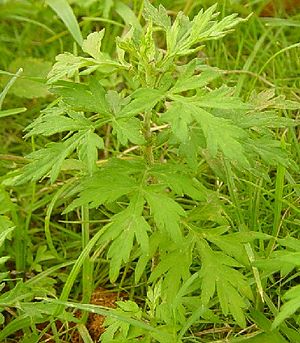Silvery wormwood facts for kids
Quick facts for kids Silvery wormwood |
|
|---|---|
 |
|
| Scientific classification | |
| Genus: |
Artemisia
|
| Species: |
argyi
|
| Synonyms | |
|
|
Artemisia argyi, often called silvery wormwood or Chinese mugwort, is a special plant. It grows year after year and has roots that spread underground. You can find this plant naturally in countries like China, Korea, Mongolia, Japan, and parts of the Russian Far East. In China, it's known as àicǎo (艾草) or ài yè (艾叶). In Japan, it's called gaiyou. People have used it in traditional medicine for a long time.
Contents
What Does Silvery Wormwood Look Like?
Silvery wormwood is a plant that stands tall, usually about one meter high. It has a grayish color and small branches. Its roots spread out underground, helping it grow in new spots.
The leaves are shaped like eggs and are deeply divided. They have tiny glands that make oil, and they feel soft and fuzzy. The bottom of the leaves is covered in white, woolly hairs. Lower leaves are about six centimeters long. They have pointed parts with small teeth along the edges. Leaves higher up are smaller and divided into three sections.
The plant's flowers grow in a tall, narrow cluster. The individual flowers are pale yellow and shaped like tubes. They are grouped together in round, hanging heads. The plant has a strong, pleasant smell.
Where Does Silvery Wormwood Grow?
This plant loves dry places. You can find it on sunny mountain slopes or along riverbanks. It also grows at the edges of oak forests, in wild areas, and next to roads or railway tracks. Silvery wormwood actually smells stronger and grows better when the soil is dry and not very rich.
How Silvery Wormwood Helps People
People gather wormwood leaves on warm, dry days in spring and summer when the plant is flowering. Then, they dry them in the shade. In traditional Chinese medicine, these leaves are thought to have special properties. They are used to help with many health issues. For example, they can act as an antiseptic to clean wounds. They also help with coughs and fevers. The herb is believed to help with women's health issues and conditions like asthma.
One interesting use is called moxibustion. This is a healing method where dried wormwood is burned. It can be shaped into cones or sticks, or placed as a ball on top of an acupuncture needle. The warmth from the burning herb is thought to help the body heal.
You can also make a tea by pouring hot water over the dried leaves. Sometimes, people crush fresh leaves to get a juice. An oil can also be taken from the leaves. This oil is sometimes sprayed into the throat to help with asthma and bronchitis, bringing quick relief.
Studies have shown that wormwood leaves can fight against certain types of bacteria. This includes bacteria that can cause infections.
New Discoveries About Silvery Wormwood
Scientists have studied the leaves and flowers of Artemisia argyi to find out what they are made of. They found many different natural chemicals. Some research suggests that the flowers might be just as helpful as the leaves for health uses.
Other studies have looked at how Artemisia argyi extracts can help. For example, one study found that an extract from the plant could reduce harmful changes in cells. Another study showed that an extract had anti-fungal power. This means it could help stop mold from growing on fruits and vegetables. Scientists also found that certain compounds from the plant might have an effect against tumors.
Researchers continue to study moxibustion and the chemicals in Artemisia argyi. They want to understand the best ways to use this plant for healing.
Traditional Uses Beyond Medicine
For thousands of years in China, the fine fibers from this plant have been used in a special way. They are mixed into the paste used for stamping seals. These seals are very important for official documents, beautiful writing, and artwork. The wormwood fibers help the paste hold its oil and color for many years without drying out. They also make sure the stamp image stays clear and doesn't smudge. People believe no other fiber works as well as Chinese Mugwort for these purposes.
Is Silvery Wormwood Safe?
Some people have said that this plant might be harmful, but there is no strong scientific proof to show this is true.

